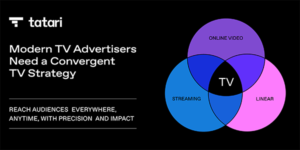When the 3D TV revolution ended at the start of 2017, some pundits, who’ve long predicted the death of TV itself, were convinced this was the final death knell.
But it wasn’t. Instead of fading out, TV flourished.
Much of this was down to TV’s recent evolution into a performance-marketing channel. It has been pushed forward by technological advancements, more timely, accurate targeting and measurement, and the ability for advertisers to optimize TV campaigns just like they do with digital.
So, with all this change, what’s next for TV and its advertisers?
Silencing Doomsday Rumors
During the next 12 months, industry naysayers will finally be forced to recognize that TV isn’t dying – not even close. It is still the most powerful marketing channel for brands, and plays a big role in the lives of consumers, even in the digital age. Let’s look at the facts.
In the U.S., adults spent almost four hours a day watching TV in 2017, accounting for the majority of video viewing time. While this number is dropping, it’s not as quickly as you might believe. Estimates see this number dropping by just five minutes in 2018, and six minutes in 2019. That’s still three hours and 47 minutes a day!
As a marketing channel, TV still reigns supreme. TV ad spend continues to grow and even digital-focused companies have been won over. E-commerce brands and tech giants –even those making their own play at “TV” like Netflix and Amazon – have become one of the biggest groups of TV advertisers.
While the role of TV in our lives is changing, it’s still influential and effective. It’s not at death’s door, not even close.
Ad Spend Coming Back to TV
In a time when “fake news” became 2017’s phrase of the year, things have been tough for the digital advertising realm. Alongside many brand safety issues — with ads placed next to offensive, even extremist, content — the industry was increasingly hit by fraud. As a result, demand for greater transparency soared, while confidence in the digital supply chain and budgets plummeted. Case in point – media giant P&G infamously cut its digital ad spend by $140 million.
Amid the chaos, a large number of brands started to reallocate spend to trusted formats, such as TV. Giving brands complete control over where and when ads appear, TV has always offered better contextual clarity and certainty, whereas digital is all about chasing cookies to target consumers at varied destinations across the web.
Until digital assumes the responsibility and cost of brand safety – providing advertisers with more control, visibility, and the assurance that they are being positioned appropriately – 2018 will see more and more brands come back to or increasing investments in TV.
Mini Ads Make Their MarkLast year saw a new format emerge on TV: mini ads. These six-second slots deliver quick-fire impact, leaving no time for viewers to switch channels or exit the room. For advertisers, these ads mean reaching a very large audience at a time when they are fully engaged in the programming – not to mention the opportunity to reuse digitally created content for TV. For networks, the ads provide more inventory and, ultimately revenue.
Expect to see mini ads become commonplace this year, especially during live events. While not ideal for direct response, they are an ideal opportunity for advertisers looking to build long-term brand awareness with these non-intrusive, frequency plays.
Better Targeting – Without AddressableAs mentioned before, advertisers consider TV to be a performance-driven channel. While it was typically used just for reach, generating response with TV – especially among the legions of viewers who have second-screen devices in their hands – has become the focus.
Advertisers are increasingly demanding a way to get better targeting with TV. And when most people think of TV and targeting, they think of addressable, a market in its infancy.
But here’s the thing: you don’t need addressable to target TV initiatives.
In recent years, new tools have emerged that can deliver real-time performance data on TV spots, enabling advertisers to gain valuable information on audience TV habits and insights into aspects of buys that drive engagement. It’s no longer about just reaching a target audience; it’s about using data to reach them in the place and time they are actually going to respond.
This year, we’ll see more advertisers leverage spot and response data to better target their TV campaigns. Expect to see networks as well push for greater targeting and measurement efforts like Open AP.
New KPIs for TVTV advertising has long been measured with GRPs, CPMs, and ratings, but 2018 will see this change significantly. Of course, these types of reach and frequency metrics will still be important – especially for brand awareness – but we’ll see advertisers turn toward more brand-specific, performance-based metrics this year.
With the right technology, measuring a sale that is directly due to TV is easy. An advertiser can tie the spot airing to an immediate action like an online sale, subscription or registration. Lower-consideration products enjoy conversions closer to the spot airing. But not every brand has that luxury.
For higher-consideration brands, the end result doesn’t happen right away and directly tying a spot to a sale becomes more difficult. In cases like this, where a purchase might not happen for days, week or months, TV advertisers will turn to action- or intent-based metrics.
A few years ago, advertisers might not think these “middle-of-the-funnel” activities would carry any monetary value. But actions that lead to sales, whether right away or weeks down the line are quantifiable and excellent indicators of TV performance.
Taking AI to the Next LevelArtificial intelligence (AI), and its subset machine learning, is integral to enhancing advertising efficiency and effectiveness. And its use is only set to increase as first- and third-party data becomes more sophisticated.
In multiple areas, from real-time marketing mix modeling to media buying, AI will overhaul existing TV planning. Not only will advertisers be able to plan on both ratings and response, but they will also get granular insights that will allow them to construct plans in minutes and even predict how ads will perform.
TV is in its next phase of evolution, and in the near future we can expect to see this resilient format getting stronger. Through new technologies, TV campaigns will be even more targeted and effective. Advertisers will optimize performance by measuring short and long-term impact. And adoption of AI will help brands find the perfect place for TV amongst their media mix. 2018 is set to be a good year for TV.


